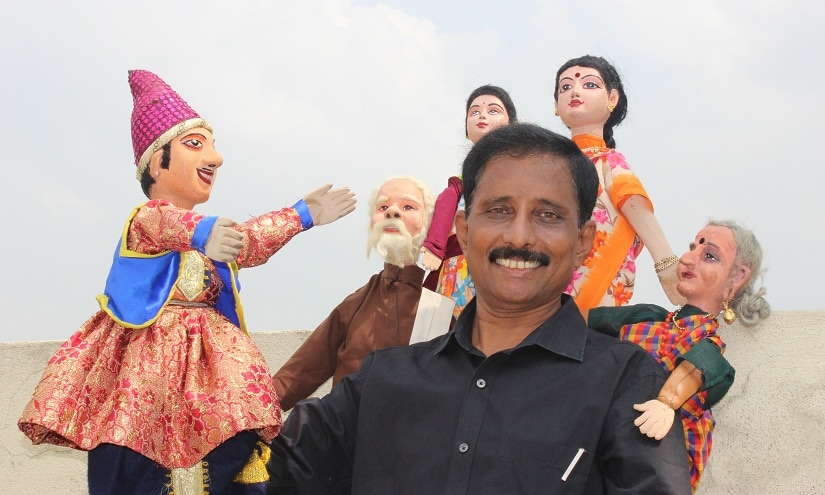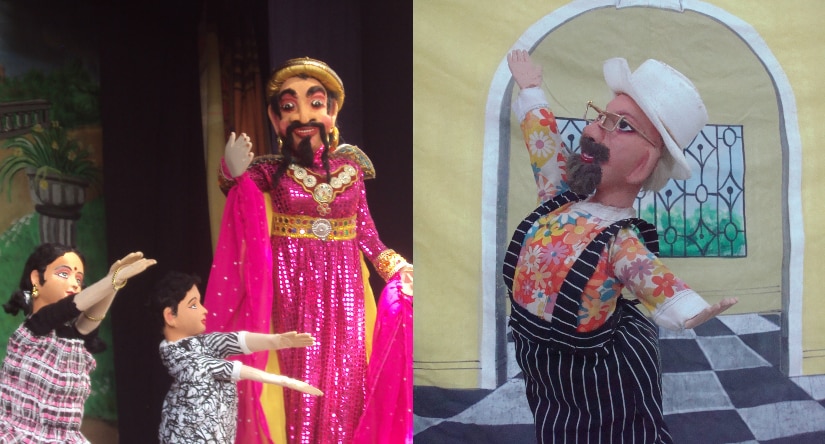As a high school student in the 70s, Mu Kalaivanan would poke fun at his teachers by creating paper dolls and making them imitate the teachers during classes. Years later, he made a career out of it. Having taught himself Bommalattam (puppetry) – one of the oldest folk art forms of Tamil Nadu – Kalaivanan is perhaps the finest of its exponents. Over the years, he has held a number of performances, and his entire family is immersed in the art. “I had a very natural interest in creating dolls and performing with them, even as a child. My father Muthu Koothan was a well-known lyricist, who wrote songs for actor-filmmaker MGR. But the opportunities given to him reduced when he had a fall out with MGR. That is when Bommalattam came in handy,” he explains. The family soon discovered Kalaivanan’s innate love for the art. Combined with Muthu Koothan’s way with words, the family began staging small Bommalattam performances in front of their home, which became a means to earn a quick buck. “I vividly remember that we used to get lot of attendees. There was no other great form of recreation available to people back then. We used to charge ten paisa per person,” he recounts. [caption id=“attachment_4485727” align=“alignnone” width=“825”]  Kalaivanan has earned the attention of the youth by taking Bommalattam outside the context of temples and mythology[/caption] Traditionally, Bommalattam – a folk art that has existed in various forms across the world – was performed predominantly in temples across Tamil Nadu. Most of these performances were based on tales of bhakti and mythology. Tamil texts that date back as far as the 10th century have references to performances of this art form. Legend has it that goddess Lakshmi used it to ward off asuras and evil people. “Various forms of Bommalattam exist. The one I specialise in is called glove puppetry; we use our hands to make the dolls move," he says. “My first performance was at Dumeel Kuppam in Chennai. It was so well received that the organisers booked me for over a hundred programs across the state. It helped me to learn and refine my craft,” he says. He took Bommalattam out of the context of temples and mythology. “As early as 1976, I was approached by the local administration to stage a performance that would raise awareness about the government’s health schemes,” he says. Since then, there has been no looking back. Kalaivanan collaborated with several NGOs to raise awareness about various issues, including education, panchayat raj, women’s rights, global warming and against superstitious beliefs. Across platforms, Kalaivanan managed to attract new audiences, thanks to his message-driven performances. “The message is always the medium. When I presented the traditional Bommalattam in a new package, it was received well,” he says. In 1984, the troupe, now called Kalaivanan Ara Peravai, was spotted by the leaders of Dravidar Kazhagam – the movement founded by Periyar. Since then, Kalaivanan has been a regular on Dravidar Kazhagam’s stages. “Once, DMK chief Karunanidhi saw our performance and was full of praise for us. Soon, he also gave us chance to perform at the DMK stages.” Kalaivanan was also a regular on the stages of Dravida Iyakka Thamizhar Peravai – a Dravidian social movement founded by Suba Veerapandiyan. [caption id=“attachment_4485731” align=“alignnone” width=“825”]  Dolls used in Bommalattam performances[/caption] For political platforms, Kalaivanan chooses to perform plays by DMK’s founder CN Annadurai and poems by the revolutionary Dravidian poet Bharathidasan. “I recently performed Anna’s Neethi Devan Mayakkam and Sivaji Kanda Hindu Rajyam. Believe me, they continue to excite young audiences." Ratna Senthil Kumar, a political activist who has watched Kalaivanan perform, agrees, “I have watched him perform several times, and I have watched Bommalattam performances by other artists too. What sets him apart is that he puts in his soul into the art form, he keeps innovating. This form gives one the space to experiment and change, which many are unwilling to try, unfortunately. It is almost like they are caught in a time warp. Kalaivanan allows the art to breathe. I have seen young people jump in excitement while watching his performances. They barely ever look into their cell phones!” Suba Veerapandiyan concurs, “This family’s life revolves around the art form. I have watched them sit around and make dolls, and rehearse. For them, it is more than a means to earn money. Of course, the art is a source of income now, but even when it wasn’t, they were just as dedicated. They wouldn’t perform a piece that went against their basic beliefs, even if they were promised huge sums of money for it.” Kalaivanan’s two sons, who are college graduates, have now forayed into the family’s craft. “They further innovate; one of them has started using LED lights, which was unheard of until now,” he says. But there is a sense of regret and lament in his voice. “Despite my individual effort, it is still a dying art. It is no longer performed in temples; evidently, music and dance performances have replaced it. If the government wills, the art can be revived, and it should be,” he asserts. He suggests that Bommalattam could be used in schools as a teaching tool. “I have helped some schools in this regard, and the results have improved. You can abandon rote learning when you have a Thiruvalluvar doll reciting couplets and explaining concepts to children. I have observed that they learn better through this method," he says. Kalaivanan also holds summer camps ever year, for those who are interested in Bommalattam. His seven-member troupe is now busy preparing for the three-day summer camp which begins on 28 May in Chennai. “Right from making the dolls to giving them voices, we teach them every aspect. The idea is to keep the art form alive,” he says.
Kalaivanan has managed to capture the interest of young Tamilians by taking the art form beyond the context of temples and mythology
Advertisement
End of Article


)
)
)
)
)
)
)
)
)



